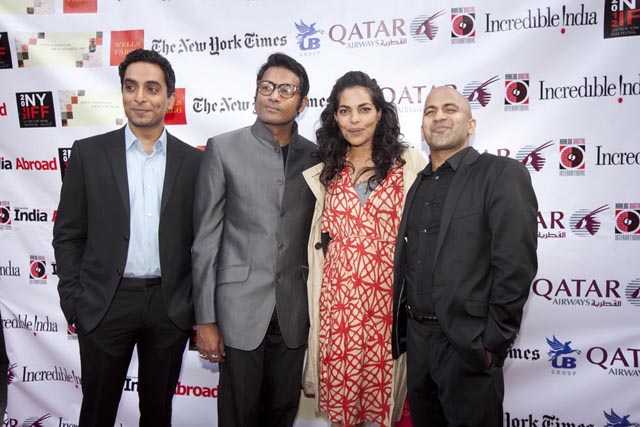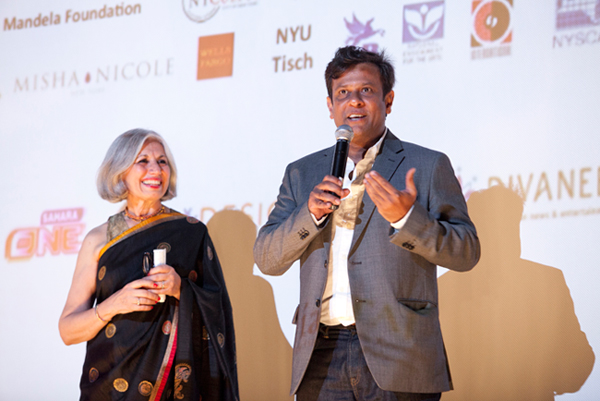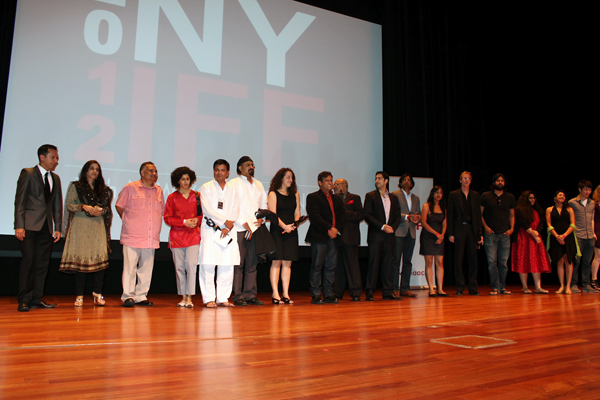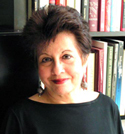
Indian American actors from left: Manu Narayan, Samrat Chakrabarti, Sarita Choudhury and Ajay Naidu.
Photo by Michael Toolan.
If there’s one thing that Indians across the world share, it’s their love for movies. As newborns, they are weaned on cinema by star-struck parents and as toddlers, their first steps are mingled with dance steps learned from Bollywood movies on video. School kids can rattle off famous dialogue from Hindi films and as young adults, they often take their cues from the romantic sequences in their favorite films. Even patriotism and national integration are often invoked by Bollywood’s rousing lyrics and over-the-top emotions.
This year marks the 100th year of Indian cinema and this vibrant industry seems to be gaining momentum and strength across the world. Immigrants have brought their love of cinema to America, carrying memories of the golden age of cinema of the 50′s, the wonderful films of V. Shantaram, Raj Kapoor, Bimal Roy, and Guru Dutt.
Then there’s that whole period of the 70′s when Amitabh Bachchan was the “angry young man” and the industry almost revolved around him. Slowly, the “masala movies” of the 70′s morphed into Bollywood, and now that catch-all phrase covers just about every movie produced by India’s multi-million dollar film industry.
Young Indian Americans have acquired this passion for film from their immigrant parents and watched countless videos from the local Indian stores. Many young people living in American towns can break into “filmi” dance at a moment’s notice. In fact, folk dances, Bollywood dancing, and bhangra have become big business in the Indian communities, with dance studios teaching all these forms. Indians carry this love into college campuses and most Indian organizations have dance teams, contests, and special events.
The compulsion to make movies about their roots began a few decades ago when young Indian Americans came of age and found brown faces were not represented at all in the mainstream cinema. American Desi was one of the first films to be made by this new generation telling their stories of cultural confusion and adjustment. For struggling actors of South Asian descent it was a difficult time when roles for them were few and far-between, and the choice was to play a taxi driver, a swami—or a terrorist.
With America’s changing demographics, a lot has changed. It’s acceptable—even cool—to be an Indian and there is an increasing array of roles for Indian faces on mainstream TV and movies. At one time many Indian parents were much more conservative about their children’s career choices—it had to be doctor, engineer or lawyer; now they are open and supportive of a wide range of choices which can be actor, director, or even stand-up comic.
There are now several Indian actors in Hollywood and independent films, including Kal Penn, Aasif Mandvi, Samrat Chakrabarti, Parminder Nagra, Sarita Choudhury, Manu Narayan, and Ajay Naidu.
At the recent New York Indian Film Festival (NYIFF) which showcased over 44 independent films and documentaries from India and the Diaspora, one got to see many films made by emerging Indian American filmmakers which proved that cinema has become a way of life for the second-generation South Asians.

New York Indian Film Festival director Aroon Shivdasani (left) with first time director
Bedabrata Pain (right). Photo by Michael Toolan.
The opening night film was Chittagong made by first time filmmaker Bedabrata Pain, who was a scientist at NASA before he decided to become a filmmaker. In fact, he has been inducted into the US Space Technology Hall of Fame for his inventions in digital imaging. This powerful film takes us to British India of the 1930′s, to a true life story of revolutionaries taking on their English Masters.
Some of the Indian Americans who showcased their films at this festival, almost always with Indian subjects, include Mukesh Vidyasagar, who made Silent Water—a film which creates awareness about clean water and raises funds for Gramalaya, a non-profit in India; Anirban Roy of Los Angeles, whose Aashpordha about teenage rebellion, has been picked up for national telecast by SBS Australia; Mridu Chandra of New York has produced award-winning films, including Himalaya Song which showed at the 2012 Sundance Film Festival. Her new film, Indian Summer, follows a real Indian-American story—children at the Hindu Heritage Summer Camp in Rochester, NY.
Many emerging filmmakers are starting out with short films and going the film festival route. Vishesh Sharma has moved only in 2000 to the US but has just finished directing his first short film Color of Anger. There’s Vivek Sharma, who has directed the 14-minute film The Plan. It will be interesting to see how the careers of these filmmakers evolve.
One filmmaker who thinks out of the box is Vikram Gandhi, a graduate of Columbia University. He’s done music videos and ad films for major corporations, but his first feature film, bagged him the Audience Award for the Best Documentary at the 2011 SXSW Film Festival. The premise is quite stunning: in Kumare he takes on religious groups and blind faith by pretending to be an Indian guru named Kumare. True to human nature, the fawning disciples really follow!

New York Indian Film Festival. Photo by Michael Toolan.
There is a lot of crisscrossing between continents: Bornila Chatterjee, who was born in Los Angeles, moved to Kolkata and then returned to the US to study at New York University’s Tisch School of the Arts. Her first feature film was seen at the NYIFF—Let’s Be Out, the Sun is Shining. It won the Audience Prize over several other films, including films from India.
Inspired by the filmmakers of the diaspora like Mira Nair, Gurinder Chadha, Deepa Mehta and M. Night Shyamalan, there are young Indian American filmmakers dreaming their dreams and making their own kind of films across the USA. Some like Nageshwar Kukonoor travel back to India to become a big success there!
So one has to watch out for all that these emerging filmmakers will be accomplishing in this 100th year of Indian cinema. They may well re-define what constitutes an Indian film, bringing all their American experiences to it.

Lavina Melwani is an award-winning journalist who has written for several international publications including: India Today, Newsday, The Week, WSJ, Travel Plus and The Hindu. She lives in New York. Her online magazine, Lassi with Lavina, is about Indian art and culture. Click here to visit her website, Lassi with Lavina.
In the following essays, she explores Indian-American life, journeys to India, America and the emerging self.

